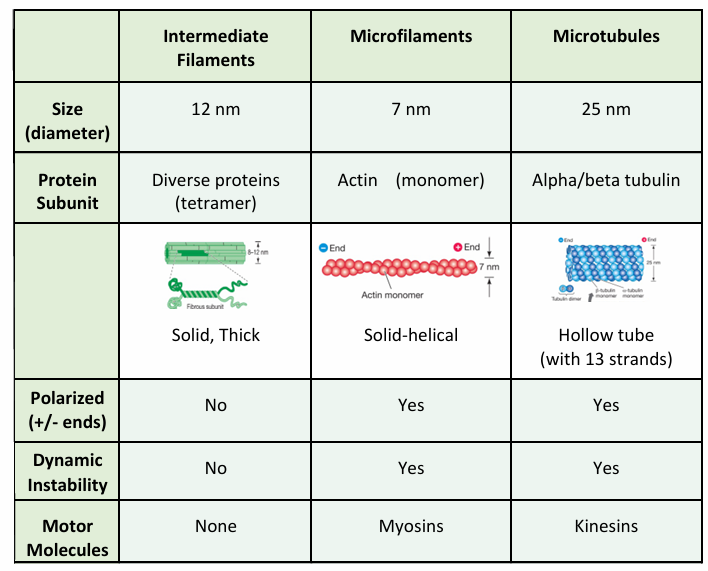Plant Phys exam 1
1/79
There's no tags or description
Looks like no tags are added yet.
Name | Mastery | Learn | Test | Matching | Spaced |
|---|
No study sessions yet.
80 Terms
All species in Plantae exhibit…
alteration of generation
How does Miosis in plants occur?
sporic meiosis
directly produces haploid spores and gametes are produced later from haploid structures by mitosis
What are some challenges to living on land?
avoiding desiccation
obtaining key minerals
reproduction in absence of H20
structural support without buoyancy
—— and ——— are the 2 glucose polymers for plants.
amylose- 1,4 glucose polymer
amylopectin- 1,4 glucose polymer + alpha side branches
____ is the primary component of plant cell walls.
cellulose β 1,4 glucose polymer
What does cellulose do?
provides structural support
very stable, rigid structure
most abundant carbon-containing (organic) biological compound on Earth
An angiosperm is…
a plant of a large group that comprises those that have flowers and produce seeds enclosed within a carpel
What are vascular systems used for in plants?
water & nutrient transport: xylem tissues
carbohydrate transport: phloem tissues
**makes up the ‘organs’ of plants- roots, shoots, leaves
What is the benefit of seeds?
act as physical protection for embryos
delay germination until favorable environmental conditions occurs
____ and _____ are unique to angiosperms.
flowers (reproductive strategy for dispersal) and fruits (dispersal of offspring)
____ and ____ are types of angiosperms.
monocot and eudicot
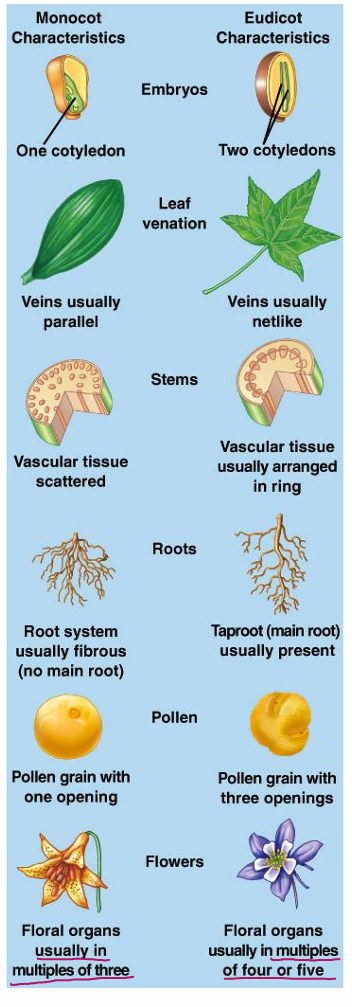
Describe cotyledons, veins, and pollen
embryonic leaves
vascular tissue organization
contains male gamete
Why are angiosperms successful?
25000+ species
present in all environments due to seed evolution
84% of terrestrial plant species
What is indeterminate growth?
What makes this possible in plants?
producing new organs throughout lifetime of organisms (shots, roots, leaves in plants)
presence of meristems
What is determinate growth?
growth of organism stops once specific structure is produced (leaves/flowers in plants
What are meristems?
a persistent site for cell division (throughout a plant’s lifetime- key to sessile plant lifestyle)
What are the two types of cells in a meristem?
1- initials: remain undifferentiated… replenish/maintain meristem
2- derivatives: divide several times to produce cells that differentiate into specific ce types/function
how are the two types of meristem cells regulated?
kept in balance by plant hormones, cell signaling, and genetic pathways
- plant growth is a result in balance of two cell types
What are the 3 types of meristems in vascular plants?
1- apical: tips of all shoots/roots
2- primary: near apical meristems
3- secondary (lateral): parallel to long axis of plant body
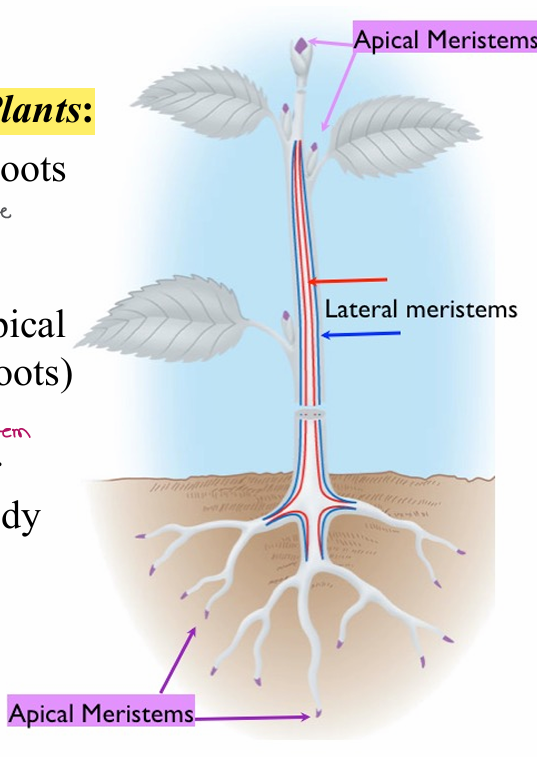
Which type of meristem is not present in all plants?
secondary meristems- produce the woodiness of plants
occur across length of organisms
Characteristics of lateral/secondary meristem
produces large increase in circumference of the plant
vascular cambium- produces the secondary vascular tissues (2 xylem/ 2 phloem)
cork cambium- produces secondary epidermal tissues
** wood inside tree is 2 xylem/bark is 2 phloem
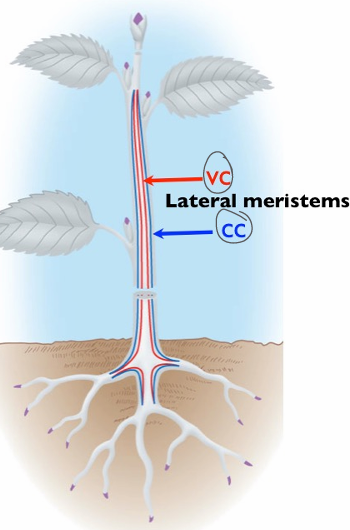
Characteristics of apical meristems
can exhibit hierarchy/dominance (produce auxin)
increase overall height/length of plant organs
key aspect of plant growth/development
derivative cells **
2 types= SAM (shoot) & RAM (root)
What type of primary meristems can derivatives cells of apical meristems become?
protoderm
procambium
ground meristem
** can produce one or more cell types- daughter cells that undergo DIFFERENTIATION
Describe the 3 types of primary meristems
protoderm- produces primary epidermal tissue
procambium- produces primary vascular tissues (xylem/phloem)
ground meristem- produces primary ground tissues that ‘fill in’ space between epidermis/vascular tissues
What are xylem and phloem tissues used for?
xylem- water and mineral transport
phloem- carbohydrate transport
Phenotypic plasticity is…
the ability to produce distinct phenotypes in response to environmental variation
Plants alter their phenotype in response to…
their environment
Plants can____ during their natural course of development
de-differentiate= highly specialized to less specialized
doesn’t usually occur in highly specialized cells
example- callus (undifferentiated mass of cells)… new cells produce suberin in cell walls to protect/cover wound site
Regeneration in tissue culture
1- induction: dedifferentiation of cell
2- proliferation of cells: produces callus
3- morphogenesis of organized structures: shoots/roots
Totipotency is…
when a single cell can dedifferentiate and produce an entirely new individual
differentiated → undifferentiated
Morphogenesis is regulated by…
auxin and cytokinin (hormones- essential to plant viability)
regulate shoot and root formation in callus
What can dedifferentiated cells do?
1- reorganize (self- assemble) to reform meristems
2- differentiate into new cell types/tissues
What are the differences between primary and secondary metabolites?
primary- essential for growth and development
secondary- not critical to plant viability— debated function
What are phytochemicals?
a type of secondary metabolite
Functions of secondary metabolites
defense & protection against insects/herbivores, microorganisms
competition with other plants
attraction/communication with beneficial organisms
How do plants communicate?
using chemicals (with same species AND other species)
Why do humans use secondary metabolites?
medicines, flavorings, pigments, recreational drugs
What characteristics do all eukaryotic cells have?
bounded by plasma membrane
nucleus
mitochondria
peroxisome
What characteristics are unique to plant cells?
glyoxysomes
plastid (eukaryotic photosynthetic organisms)
plant vacuole
plant cell wall
What is the fluid mosaic model?
phospholipid bilayer
fluids are regulated by components of bilayer
steroids and fatty acid tails
plants have 1-3 double bonds in a SINGLE tail
Why is it important for plants to have more double bonds?
at lower temperatures it allows plants to be more fluid
Describe passive transport
movement from high to low (down concentration gradient)
NO ENERGY REQUIRED
When can substances pass through the bilayer?
if lipid- soluble OR small
uncharged/polar require transport protein
Describe Active transport
movement against chemical gradient
REQUIRES ENERGY (ATP)
Describe 2nd active transport (co-transport)
movement down concentration gradient is coupled with movement of 2nd substance against concentration gradient
H+ gradients
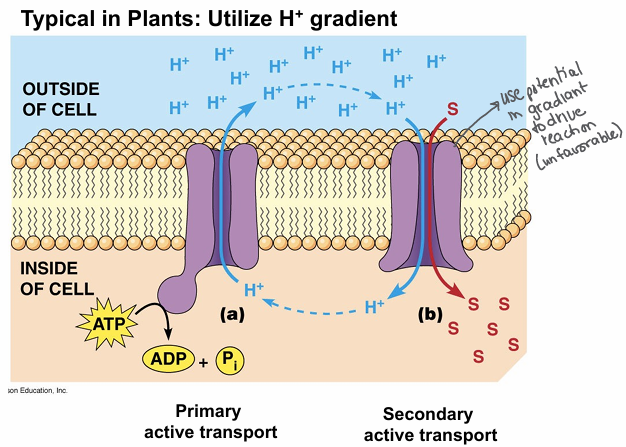
Describe the difference between symporter and antiporter
Symporter- moving in same direction
antiporter- moving in opposite direction
Plant cells DO NOT HAVE….
a Na+/K+ pump
What is the endomembrane system?
a collection of organelles that work together to synthesize, modify, and transport proteins and membranes amongst themselves (proteins/lipids)
connected directly (nuclear envelope/ER) or indirectly (transport vesicles)
Where does protein synthesis begin and end?
all begin in cytosol
end in either cytosol OR associated with ER
What is the role of smooth (tubular) ER?
calcium storage, steroid synthesis, phospholipid synthesis, enzymes to detoxify drugs
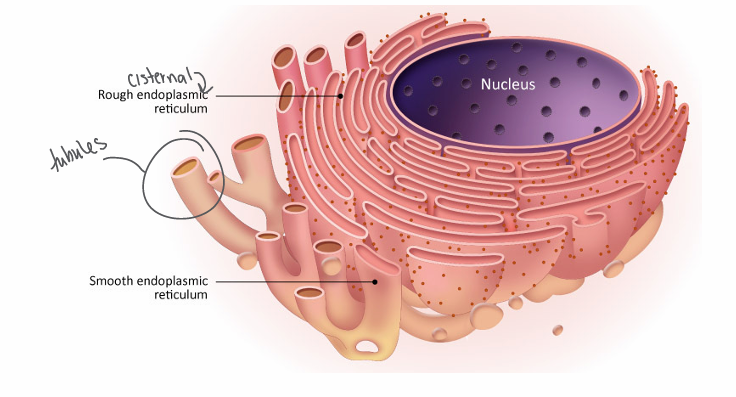
What is the role of rough (cisternal) ER?
calcium storage, site for protein synthesis, protein folding, glycosylation of proteins and lipids
Describe the Golgi structure
enzymes in golgi stacks are unique and different
only 1 part of golgi receives material from ER
highly polarized
function: glycosylation reactions (sequential); produces sugar for cell walls
N-linked vs O-linked oligosaccharides
N: added in ER, 14 sugar residue(initially), covalently attached to protein througha nitrogen, modified extensively in glogi
O: added in gogli, 1-4 sugar resides, covalently attached, added one at a time to protein, attached to protein through oxygen
How does material move through the PLANT golgi?
vesicles move forward and backward
enzymes move backward in same stack
consistent formation of new stacks (permanent structure)
vesicles go to vacuole, lysosome, or to plasma membrane (to exocytosis)
What is the equivalent of lysosomes (animals) in plants?
plant vacuoles… small vesicles bud from golgi and fuse to form the vacuole… delivering additional material/proteins to mature vacuole
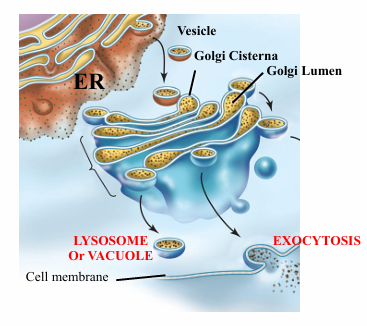
What is autophagy?
the destruction pf large cellular components including entire organelles
ER derived membrane encloses organelle
organelles digested/broken down by enzymes in LYSOSOME
** also function in plant vacuole
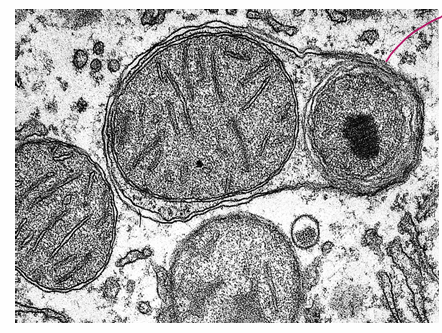
What is endocytosis?
uptake of large extracellular material into cell
cell membrane surrounds extracellular material
** also function in plant vacuole
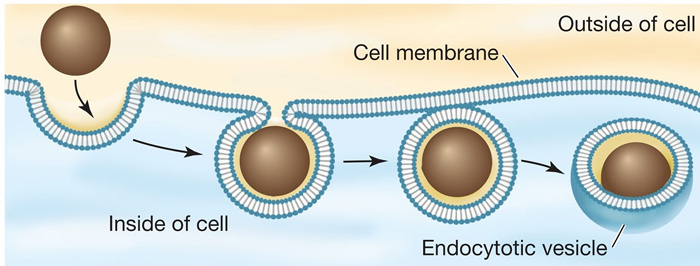
What is phagocytosis?
uptake of VERY large matter… vesicle formed is a phagosome which fuses to lysosome
a type of endocytosis
2 TYPES- nutrition OR defense
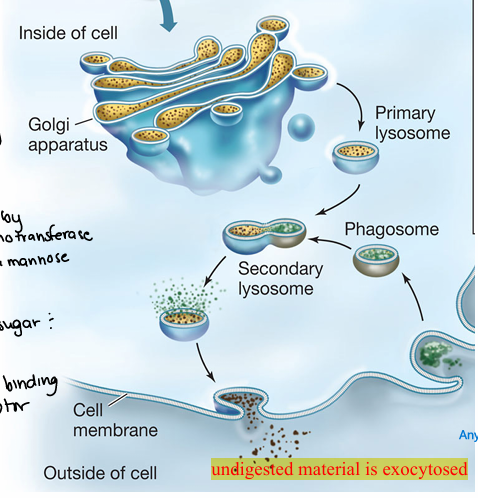
Functions of plant vacuoles
storage: solutes and water
important role in water balance of plant cells (positive turgor pressure to withstand gravity/upright growth)
allows for large increase in plant cell size
can have a lytic function during embryogenesis
golgi dependent OR independent (different receptors/proteins)
Why are lysosomes and vacuoles considered distinct organelles?
each has different receptors and signals
How do plastids evolve?
From primary endosymbiotic events (proplastids in embryo)
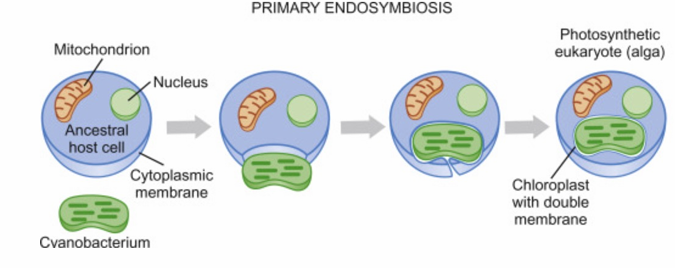
What are proplastids?
undifferentiated plastids-meristems, egg cells, pollen grains, embryo)
absence of light- proplastids→ etioplasts
presence of light → thylakoids form and chlorophyll pigments develop
Light regulates…
transcription of genes required for thylakoid and pigment maturation
What are chloroplasts?
a type of plastid
LEAVES
primary function= photosynthesis
light RXNs- thylakoids
light independent RXN: stroma
What are other types pf plastids?
chromoplasts: pigmented… primary in reproductive functions (flowers)
leucoplasts: non pigmented… function in carbon storage
** plastid function depends on position in plant body
What are oleosomes?
oil storing bodies (triglycerides)
primarily found in embryos… derived from ER
** unique to plants
What are glyoxysomes?
unique peroxisomes found primarily in embryos storing lipids/triglycerides for use as energy source during germination (single celled)
function- produces acetyl CoA from beta oxidation of fatty acids
Glyoxoysomes can transition into…
peroxisomes during seedling development
major site of O2 utilization
must remove hydrogen peroxide
What can plant cells do with acetyl CoA?
broken down by mitochondria to produce ATP
make glucose from lipids in a single cell (gluconeogenesis)
What is gluconeogenesis?
creating lipids to sugars for energy
Define the cytoskeleton.
a dense network of protein filaments in the cytoplasm of the cell
1- microfilaments
2- intermediate filaments (not in plants)- cellular integrity/support
3- microtubules- determine/maintains cell shape, intracellular transport (kinesins), whole cell motility
Microtubules movement
**unidirectional
homologous OR unique
- end: embedded in spindle pole + end: growth happens here
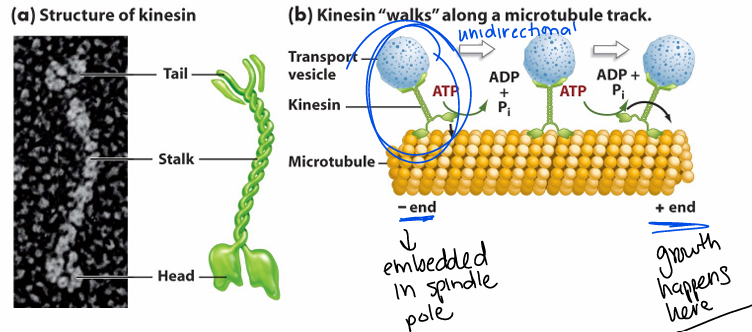
Cilia vs flagella
cilia- short, multiple present… fluid moves over stationary object/cells
flagella- longer, few present… push/pull cell through water
** composed of microtubules
Microtubule structure
alpha (-)/beta (+) tubulin dimers
13 protofilaments
dimer= alpha + beta
monomers bound by GTP
centrosomes and basal bodies (organizing center)
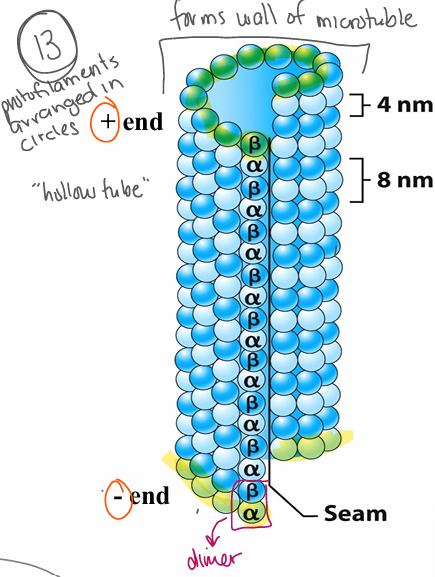
Microtubules and Microfilaments exhibit…
dynamic instability (rapid growth, depolymerization, reformation)
Centrosomes vs basal bodies in microtubules
centrosomes- polymerize cytoplasmic microtubules
basal bodies (responsible for organizing) and polymerize cilia and flagella
**both have structures consisting of 9 triplet microtubules
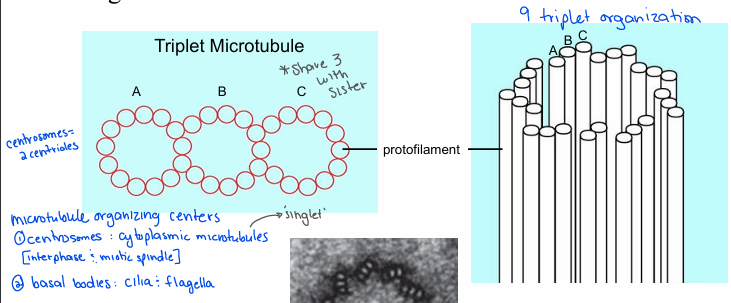
Centrosome vs centrioles (NOT IN PLANTS)
centrosomes- 2 centrioles perpendicular to each other/ proteins assist in polymerization of microtubules
centrioles- 9 triplet microtubules arranged in a circle (replicated during S-phase)
** replicate semi conservatively
Microfilament function
determine/maintains cell shape
generate contraction forces within cell
responsible for whole cell motility
intracellular motility/movement
(Actin protein- composed of actin monomers
most plants use actin for long distance transport
Myosin…
only moves towards + end of microfilaments
requires NRG
can generate tension/contraction when anchored to cell structure
** changes in cell shape
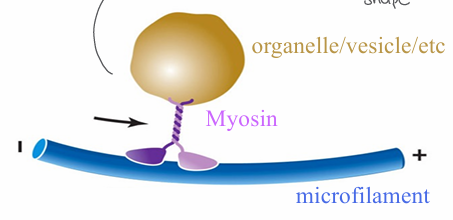
Characteristics of cytoskeleton
